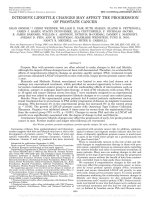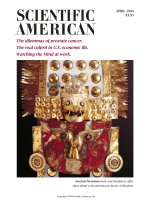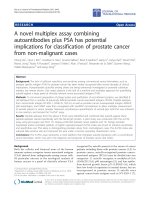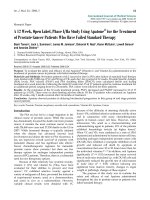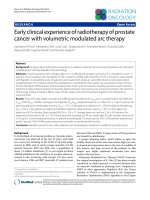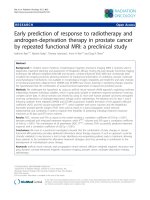Assesment of treatment of prostate cancer by endocrine therapy at 103 Military Hospital
Bạn đang xem bản rút gọn của tài liệu. Xem và tải ngay bản đầy đủ của tài liệu tại đây (86.55 KB, 5 trang )
Journal of military pharmaco-medicine no1-2019
ASSESMENT OF TREATMENT OF PROSTATE CANCER BY
ENDOCRINE THERAPY AT 103 MILITARY HOSPITAL
Nguyen Anh Tuan1; Tran Van Hinh1; Pham Quang Vinh1; Nguyen Phu Viet1
Dao Van Nhat1; Nguyen Dinh Duong1; Cao Quyet Thang1; Le Anh Tuan1
SUMMARY
Objectives: To evaluate the results of treatment of prostate cancer by endocrine therapy.
Subjects and methods: All cases with prostate cancer were diagnosed by histopathology,
treated by endocrine. Evaluating the results after 3 months, 6 months, and over 1 year. Results:
After endocrine therapy over 12 months, PSA total level < 4 ng/mL (53.16%); from 4 - 10 ng/mL:
27.84%; > 10 ng/mL: 11.39%. PSA total level decreased from 35.1 ± 1.2 ng/mL to 7.88 ± 5.15 ng/mL
(p < 0.05). Good result: 88.61%; bad result: 11.39%. Conclusions: After treatment for over
12 months for 79 prostate cancer patients treated by endocrinology, total PSA levels were
< 4 ng/mL (53.16%); 4 - 10 ng/mL (27.84%); > 10 ng/mL (11.39%). The total PSA level
decreased from 35.1 ± 17.2 ng/mL to 7.88 ± 5.15 ng/mL, significantly different with p < 0.05.
Good and moderate results after hormone treatment and follow-up was 88.61%. On the other
hand, bad results accounted for 11.39%.
* Keywords: Prostate cancer; PSA; Endocrine therapy.
INTRODUCTION
Prostate cancer is the leading cause of
urologic diseases and the second most
common cancer in men. It is more common
in men over the age of 50, the second
leading cause of death in the world after
lung cancer [2, 5, 6]. In Vietnam, the
incidence of prostate cancer is increasing,
possibly due to the growing economic
conditions, the longevity of life. With
today's modern screening and diagnostic
facilities such as ultrasonography, blood
PSA quantification, prostate biopsy as
histopathology [3], along with advanced
treatment techniques such as combination
therapy and radical surgery, radiotherapy,
chemotherapy and endocrine treatment
are the chosen methods, which are suitable
with the disease as well as the current
socio-economic conditions of our country.
Currently, endocrine treatment is a highly
effective treatment method that is widely
used in many domestic and international
health facilities, especial for patients with
the end stage of prostate cancer [1, 4].
Vietnamese studies on endocrine treatment
for patients with prostate cancer are not
much. From that fact, we conducted
the research aimed at: Assessment of
prostate cancer by endocrine therapy at
103 Military Hospital.
1. 103 Military Hospital
Corresponding author: Tran Van Hinh ()
Date received: 20/10/2018
Date accepted: 17/12/2018
145
Journal of military pharmaco-medicine no1-2019
SUBJECTS AND METHODS
1. Subjects.
- 79 prostate cancer patients were
diagnosed with prostate cancer based on
histopathological findings, treated and
surveyed at the Urological Surgery
Department of the 103 Hospital from
1 - 2013 to 5 - 2018.
- Criteria for selecting patients:
- There are 3 levels of evaluation:
+ Good: Total PSA level < 4 ng/mL; no
distant metastasis; duration of living over
3 years.
+ Moderate: Total PSA level 4 - 10 ng/mL;
complications.
+ Bad: Total PSA > 10 ng/mL; there are
distant metastases.
* Data processing:
+ Diagnosed finally prostate cancer by
histopathology.
Data were entered and processed
by statistical software in SPSS 16.0 and
Excel 2010.
+ Used endocrine agents with enough
dose and times at 103 Military Hospital.
RESULTS AND DISCUSSION
+ Full documentation of clinical, treatment
and development during hospitalization.
- Exclusion criteria:
+ Patients do not agree to enroll in
the study.
+ Patients who are diagnosed with
histopathology and treatment by other
medical centers.
Patients diagnosed with prostate cancer
without histologic results, incomplete records
of treatment and follow-up.
2. Methods.
- Case, description study.
- Process: Patients were diagnosed
with prostate biopsy on histopathology,
histopathological classification, Gleason
score, blood PSA level before and after
endocrine treatment 3 months, 6 months
and over 1 year.
- Endocrine agents: Diphereline 3.75 mg
every 3 months.
146
1. Characteristics of patients.
* Age of patients (n = 48):
< 50 years old: 1 patient (1.26%);
51 - 60 years old: 4 patients (5.06%);
61 - 70 years old: 28 patients (35.44%);
71 - 80 years old: 30 patients (37.97%);
> 80 years old: 17 patients (21.51%).
The mean age of patients with prostate
cancer in this study was 71.25 ± 7.7.
The youngest was 48, the oldest was 94.
The age over 80 accounted for not high.
In Vietnam, there is no specific research
on age with a large scale, but many authors
recognized that prostate cancer is the
major disease of older men. In our study,
the prevalence of the disease increased
with age, particularly in the 61 - 80 age
groups (73.51%). The prevalence of this
disease was less than 6.32% in the age
group 50 - 60 years old. This result was
consistent with that of Nguyen Viet Hai
(2013). The incidence of the disease
increased with age, most commonly in
the 61 - 80 age group, but the highest
Journal of military pharmaco-medicine no1-2019
was in the 71 - 80 age group [2], and also
higher in the average age of the disease
[6, 8]. This can be explained by the fact
that the health care system with prostate
cancer screening in highly productive
countries has helped to diagnose early
onset of metastatic disease. This is
important for survival time and quality
of life. Moreover, early detection and timely
treatment with multiple methods also reduce
the risk of death.
Table 1: Features of differentiation of
cells in the study group.
n
Percentage
(%)
High (Gleason 2 - 4 scores)
12
15.18
Moderate (Gleason 5 - 7 scores)
45
56.96
Low (Gleason 8 - 10 scores)
22
27.84
79
100
Differentiation of cells
Total
There were no significant differences
in the number of authors (Bostwick,
Nguyen Viet Hai, 98.6%). Other histopathologic
lesions of the prostatic hypertrophy were
sarcoma and urothelial carcinoma (3.8%).
According to the classification based
on Gleason points, the most useful
classification in prostate cancer, the study
showed the most common was the low
and medium cell differentiation (84.80%),
high cell differentiation was less common.
The results of this study were well suited
to other domestic and international studies
[2, 7]. High differentiation with good prognosis,
especially those with non-invasive prostate
gland tumor, non-invasive lymph nodes
are able to completely cure, so have
better prognosis, long life after treatment,
long low ability to respond to treatment,
aggressive invasive disease, high rate of
metastasis, rapid progression and death
in short time.
* Histopathological features:
Urothelial: 1 patient (1.26%); sarcoma:
2 patients (2.53%); carcinoma: 76 patients
(96.2%).
* Total PSA serum levels before endocrine
treatment:
< 10 ng/mL: 3 patients (3.79%);
10 - 20 ng/mL: 11 patients (13.92%);
20.1 - 50 ng/mL: 26 patients (32.91%);
50.1 - 100 ng/mL: 35 patients (44.30%);
> 100 ng/mL: 4 patients (5.06%). PSA levels
were very high in 79 patients, showed that
most patients admitted to the hospital
late; average PSA 35.1 ± 17.2 ng/mL.
Total serum total PSA levels are an
important predictor of disease but have no
predictive effect, evaluating the outcome
after endocrine treatment due to no
predictable duration of drug resistance
and survival time. Increased PSA levels
prior to treatment and postprandial
depletion are more likely to be fatal than
cases of full-blown PSA before treatment
and post-treatment reductions [5]. In our
study, total serum total PSA serum level
was higher than 10 ng/mL, accounting for
96.31%. According to Nguyen Viet Hai
and other domestic and foreign authors,
we also found that early detection of PSA
< 10 ng/mL and lowering of the diagnostic
age could completely cure the disease
and significantly reduce death, prolong life
of patients.
147
Journal of military pharmaco-medicine no1-2019
2. Results.
Table 2: PSA levels after 3 months, 6 months, and over 1 year (n = 79).
PSA serum levels
(ng/mL)
3 months
6 months
Over 1 year
<4
12
35
42
4 - 10
44
32
28
> 10
23
12
9
79
79
79
12.88 ± 7.35
9.88 ± 6.35
7.88 ± 5.15
3.25 - 48.52 ng/mL
2.25 - 25.52 ng/mL
1.5 - 20.50 ng/mL
Total
Mean of PSA
Min-max of PSA
In our study, patients were tested for serum PSA after treatment. After 3 months of
treatment, patients had PSA levels of 4 - 10 ng/mL accounted for the highest rate
(55.69%). Patients with PSA > 10 ng/mL remained relatively high at 29.11%. Through
endocrine treatment and follow-up of serum PSA levels after 6 months and more than
one year, we found that patients with PSA < 4 ng/mL had significantly increased,
accounting for 53.16%. Patients with PSA > 10 ng/mL reduced to 11.39%.
Table 3: Treatment results.
Results
3 months
6 months
Over 1 year
Good
15.18
44.3
53.16
Moderate
55.69
40.5
35.44
Bad
29.11
15.51
11.39
There is currently no standard for the
evaluation of prostate cancer treatment
outcomes. Our study based on serum
total PSA variability after 3 months,
6 months and over 1 year of treatment.
The results showed that the rate of good
results and average after treatment by
hormone and follow-up accounted for a
high rate (88.61%). Bad results accounted
for 11.39% due to the number of patients
coming to the clinic in the late stage, due
to low level of knowledge, no sense of
follow-up appointment for additional
treatment in time. Total PSA decreased
148
from 35.1 ± 11.2 ng/mL to 7.88 ±
5.15 ng/mL, significant difference with
p < 0.05. We found a significant reduction
in total PSA levels in the Gleason group
of patients, with a statistically significant
difference with p < 0.05.
CONCLUSIONS
Through study of 79 prostate cancer
patients treated by endocrinology, we draw
some comments:
- After treatment for over 12 months,
total PSA levels were < 4 ng/mL (53.16%);
4 - 10 ng/mL (27.84%); > 10 ng/mL (11.39%).
Journal of military pharmaco-medicine no1-2019
- The total PSA level decreased from
35.1 ± 17.2 ng/mL to 7.88 ± 5.15 ng/mL,
significantly different with p < 0.05.
- Good and moderate results after
hormone treatment and follow-up were
88.61%.
- Bad results accounted for 11.39%.
REFERENCES
1. Nguyễn Hoàng Đức, Trần Lê Linh Phương.
Một số quan điểm mới về điều trị nội tiết trong
ung thư tuyến tiền liệt. Thời sự Y học. 2006, 11,
tr.35-42.
2. Nguyễn Việt Hải. Nghiên cứu mô bệnh
học và chẩn đoán ung thư tuyến tiền liệt.
Luận án Tiến sỹ Y học. Học viện Quân y.
Hà Nội. 2013.
3. Vũ Văn Tỵ. Tầm soát ung thư tuyến
tiền liệt. Tạp chí Y học Việt Nam. 2010, 2,
tr.282-285.
4. Abrahamsson P.A, Anderson J, BocconGibod L et al. Risks and benefits of hormonal
manipulation as monotherapy or adjuvant
treatment in localized prostate cancer.
Eur Urol. 2005,48 (6), pp.900-905.
5. Bostwick D. G, Liu L, Brawer M.K et al.
High-grade prostatic intraepithelial neoplasia.
Rev Urol. 2004, 6 (4), pp.171-179.
6. Hankey B.F, Feuer E.J, Clegg L.X et al.
Cancer surveillance series: interpreting trends
in prostate cancer - part I: Evidence of the
effects of screening in recent prostate cancer
incidence, mortality, and survival rates. J Natl
Cancer Inst. 1999, 91 (12), pp.1017-1024.
7. Oesterling J.E, Jacobsen S.J, Chute
C.G et al. Serum prostate-specific antigen in a
community-based population healthy men.
Establishment of age °n,Qf reference ranges.
JAMA. 1993, 270 (7), pp.860-864.
8. Zhou M, Epstein J.I. The reporting of
prostate cancer on needle biopsy prognostic
and therapeutic implications and the utility of
diagnostic markers. Pathology. 2003, 35 (6),
pp.472-479.
149
